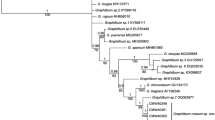Abstract
The occurrence of Cryptococcus neoformans var. neoformans and other yeast-like fungi of clinical interest in decaying wood inside tree trunk hollows, bark and other plant materials is reported. The var. neoformans was isolated from 3 of 45 (6.6%) wood and one of 390 Eucalyptus bark samples. Two of the positive wood samples came from a tree trunk hollow of Butea monosperma (Family: Papilionaceae) growing in Roshan Ara Garden, Old Delhi whereas the third was from a trunk hollow of Tamarindus indica (Family: Papilionaceae) growing outside of Talkatora Garden, New Delhi. The solitary positive Eucalyptus bark sample originated from Amritsar. The isolations of var. neoformans from decaying wood inside trunk hollows of B. monosperma and T. indica constitute the first record of the natural occurrence of this pathogen in association with these trees. The observation reinforces the recent evidence for decaying wood inside trunk hollows of some trees to be a new natural habitat of the variety neoformans. Besides, in consonance with their essentially saprobic character, a number of other yeast-like fungi were sporadically isolated. This includes, Cryptoccus laurentii Cryptococcus albidus Candida lusitaniae C. guilliermondii C. krusei C. tropicalis C. zeylanoides Trichosporon cutaneum Rhodotorula mucilaginosa R. glutinis Geotrichum capitatum G. klebahnii and Sporobolomyces salmonicolor. Cryptococcus neoformans var. gattii was not found in any of the 702 samples of plant materials, including the bark and detritus of Eucalyptus camaldulensis and E. tereticornis trees. A more extensive environmental survey, covering divergent climatic regions, is warranted to identify the natural reservoirs of var. gattii in India.
Similar content being viewed by others
References
Kwon-Chung KJ, Bennett JE. Medical Mycology. Philadelphia: Lea and Febiger, 1992; 397.
Casadevall A, Perfect JR. Cryptococcus neoformans. Washington, DC, ASM Press, 1998.
Sanfelice F. Contributo alla morfologia e biologia dei blastomiceti che si svillupano nei succhi di alcuni frutti. Ann Igien 1894; 4: 463-495.
Emmons CW. Isolation of Cryptococcus neoformans from soil. J Bacteriol 1951; 62: 685-690.
Emmons CW. Saprophytic sources of Cryptococcus neoformans associated with the pigeon (Columba livia). Am. J Hyg 1955; 62: 227-232.
Emmons CW. Prevalence of Cryptococcus neoformans in pigeon habitats. Pub Hlth Rep 1960; 75: 362-364.
Staib F. Pflanzen als Nahrsubstrat fur Cryptococcus neoformans. Zbl Bakt Hyg, 1. Abt Orig A 1971; 218: 486-495.
Staib F, Breyer D, Kulins G, Senska M, Wulkow R. Heu, ein Nahrsubstrat fur Cryptococcus neoformans. Zbl Bakt Hyg, 1. Abt Orig A 1972; 222: 407-414.
Staib F, Thielke C, Randhawa HS, Senska M, Kulins G. Colonization of dead plants by Cryptococcus neoformans. Zbl Bakt Hyg, 1. Abt Orig A 1972; 222: 115-125.
Lopez-Martinez R, Castanon-Olivares LR. Isolation of Cryptococcus neoformans var. neoformans from bird droppings, fruits and vegetables in Mexico City. Mycopathologia 1995; 129: 25-28.
Lazera MS, Pires FDA, Camillo-Coura L, Nishikawa MM, Bezerra CCF, Trilles L, Wanke B. Natural habitat of Cryptococcus neoformans var. neoformans in decaying wood forming hollows in living trees. J Med Vet Mycol 1996; 34: 127-131.
Ellis DH, Pfeiffer TJ. Natural habitat of Cryptococcus neoformans var. gattii. J Clin Microbiol 1990; 28: 1642-1644.
Pfeiffer TJ, Ellis DH. Environmental isolation of Cryptococcus neoformans var. gattii from Eucalyptus tereticornis. J Med Vet Mycol 1992; 30: 407-408.
Kreger-van Rij NJW (ed.). The Yeasts: a taxonomic study; 3rd ed., Amsterdam, The Netherlands, Elsevier Science Publ., 1984.
Kwon-Chung KJ, Polacheck I, Bennett JE. Improved diagnostic medium for separation of Cryptococcus neoformans var. neoformans (serotypes A and D) and Cryptococcus neoformans var. gattii (serotypes B and C). J Clin Microbiol 1982; 15: 535-537.
Kwon-Chung KJ, Wickes BL, Booth JL, Vishniac HS, Bennett JE. Urease inhibition by EDTA in the two varieties of Cryptococcus neoformans. Infect Immun 1987; 55: 1751-1754.
Gonzalez AE, Martinez AT, Almendros G, Grinbergs J. A study of yeasts during the delignification and fungal transformation of wood into cattle feed in Chilean rain forest. Antonie van Leeuwenhoek 1989; 55: 221-236.
Lazera MS, Wanke B, Nishikawa MM. Isolation of both varieties of Cryptococcus neoformans from saprophytic sources in the city of Rio de Janeiro, Brazil. J Med Vet Mycol 1993; 31: 449-454.
Pfeiffer T, Ellis D. Environmental isolation of Cryptococcus neoformans var. gattii from California. J Infect Dis 1991; 163: 929-930.
Chakrabarti A, Jatana M. Kumar P, Chatha L, Kaushal A, Padhye AA. Isolation of Cryptococcus neoformans var. gattii from Eucalyptus camaldulensis in India. J Clin Microbiol 1997; 35.3340-3342.
Montagna MT, Viviani MA, Pulito A, Aralla C, Tortorano AM, Fiore L, Barbuti S. Cryptococcus neoformans var. gattii in Italy. Note II. Environmental investigation related to an autochthonous clinical case in Apulia. J Mycol Med 1997; 7: 93-96.
Lazera MS, Cavalcanti MAS, Trilles L, Nishikawa MM, Wanke B. Cryptococcus neoformans var. gattii-evidence for a natural habitat related to decaying wood in a pottery tree hollow. Med Mycol 1998; 36: 119-122.
Callejas A, Ordonez N, Rodriguez MC, Castaneda E. First isolation of Cryptococcus neoformans var. gattii, serotype C, from the environment in Colombia. Med Mycol 1998; 36: 341-344.
Padhye AA, Chakrabarti A, Chander J, Kaufman L. Cryptococcus neoformans var. gattii in India. J Med Vet Mycol 1993; 31: 165-168.
Abraham M, Mathews V, Ganesh A, John TJ, Mathews MS. Infection caused by Cryptococcus neoformans var. gattii serotype B in an AIDS patient. J Med Vet Mycol 1997; 35: 283-284.
De Hoog GS, Guarro J. Atlas of Clinical Fungi. Barrn and Delft: Centraalbureau voor Schimmelcultures, The Netherlands; Reus: Universitat Rovira I Virgili, Spain, 1995.
Sutton DA, Fothergill AW, Rinaldi MG. Guide to Clinically Significant Fungi. Baltimore. Williams and Wilkins, 1998.
Author information
Authors and Affiliations
Rights and permissions
About this article
Cite this article
Randhawa, H., Mussa, A. & Khan, Z. Decaying wood in tree trunk hollows as a natural substrate for Cryptococcus neoformans and other yeast-like fungi of clinical interest. Mycopathologia 151, 63–69 (2001). https://doi.org/10.1023/A:1010906220888
Issue Date:
DOI: https://doi.org/10.1023/A:1010906220888




